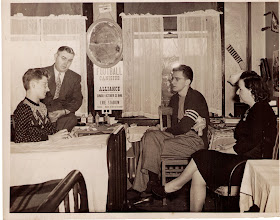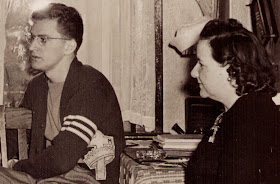The photo, below, of Gene and Casey before-the-war, or before their war, featured, naturally, in the Japanese Christmas card post. Dr. John, our JFZ, has since confirmed that the location is the back yard of May St. Thanks, John!
Incidentally, that means that JPZ's garden was in a strip along that fence behind the lads. I remember strawberry plants and tomato plants thriving in that little patch in the middle of Buffalo.
Late 1942 or 1943: Gene is drafted into the Army;
1943: Gene does Basic Training at Fort Benning, Georgia;
1943: Julia Mostkowska Zdrojewska dies of cardiac arrest while Gene is doing Basic and Casey is in late grammar school or early high school;
1944: Gene is at University of Chicago studying the Japanese language;
1944-45: Gene is in China; returns via Suez to Scotland, then home.
1946, August: JPZ and Eleanor Kotwas marry;
1947: Gene is President of St. Luke's Youth Council.
Given all that, what can we construe from the photo below?
Eleanor is there - Busia to me and to all the children of Gene and of Casey - and I really want to know if she is wearing silk or nylon stockings. Controlling our curiosity on this sartorial point, we see that Gene is wearing the famous blue sweater with the three white stripes, so he must be current CYC Prez. The setting is a dorm room. So this is some time during academic year '46-'47 or '47-'48.
Click to enlarge and then take a squint at the poster announcing the football game. It's coming up - Canisius versus Alliance - on August 13, 1946. Or it took place then, and the poster is a memento.
John recalls that Casey attended St. John Kanty Preparatory School in Erie, Pennsylvania.
What year did he graduate?
I love Casey's sweater, and his proto-James-Dean hairstyle.
John comments:
I'm convinced it"s Kanty. Note the flyer about the Canisius-Alliance football game at Erie Stadium. The no longer operating Alliance College in Erie was founded by the Polish National Alliance. My mother's brother, William Kotwas, DDS, of Auburn was a member of the Board of Trustees there for a time and we went to one of its graduations during that period.
. . . I believe one of the Zdro videos shows him in the graduation processional.
And interestingly do you see how the photographer, JPZ, set the photo up using the football game flyer to tell us the time and location? A sense of history!
John
John
The school operated from 1919-1980, when for some reason, and despite high enrollment, it was abandoned, the property sold and the building demolished.
 |
| St. John Kanty Prep, exterior of the building featured in the JPZ dorm-room shot. |
 |
| The school's statue of St. John Kanty, which was at the main entrance. |
John Cantius, Joannis Cantii, Jan Kanty, 1390-1473, was a Scholastic philosopher and academician in Krakow, at what would become Jagiellonian University.
Scholasticism is described on Wikipedia in this wise: "Not so much a philosophy or a theology as a method of learning, scholasticism places a strong emphasis on dialectical reasoning to extend knowledge by inference, and to resolve contradictions. Scholastic thought is also known for rigorous conceptual analysis and the careful drawing of distinctions. In the classroom and in writing, it often takes the form of explicit disputation: a topic drawn from the tradition is broached in the form of a question, opponents' responses are given, a counterproposal is argued and opponent's arguments rebutted. Because of its emphasis on rigorous dialectical method, scholasticism was eventually applied to many other fields of study."
One admirer of Jan Kanty was Eric P. Kelly, "an American journalist, academic and author of children's books. He was a professor of English at Dartmouth College and briefly a lecturer at the Jagiellonian University in Krakow. He won the 1929 Newbery Medal recognizing his first published book, The Trumpeter of Krakow, as the preceding year's most distinguished contribution to American children's literature."
Kelly loved Krakow, and wrote his 1929 juvenile novel about the trumpeters of the Hejnal at St. Mary's, their traditions, struggles, and heroics. He set it in 1461 and brought in Jan Kanty as one of the heroes of the tale. Here is an excerpt from Chapter IV, "The Good Jan Kanty."
"Among the most remarkable personages of Krakow's age of glory in the fifteenth century was a certain scholar-priest by the name of Jan Kanty. He had been educated at the University of Krakow in the period of late Scholasticism when the chief teachings were still mere expositions of the seven arts, of which grammar was the king. However, a full life and much contact with men had made Jan Kanty a well-rounded man. He loved learning for its own sake, but he honored most of all its precepts and its application to life, and he gave himself over in his cell-like quarters on the lower floor of the old university building (now long since destroyed by fire), to the creation of new points of view on old subjects, to comments on the conduct and opinions of the masters and doctors of the university at the great church councils of Europe, and to an intellectual chronicle of his age."
"His life was saintly and his cell was as much visited, perhaps, as is his shrine in the magnificent old university library today. The peasants loved him especially, and this was rather curious since the men from the farms rarely sought the advice of the men of the university; they were, in fact somewhat shy of the dispensers of higher learning. They were not shy of Jan Kanty, however. They came to Krakow to ask his opinion on the weather in the seasons of grains and vegetables, they called upon him for decisions in disputes between landowners, they consulted him concerning the proper kind of food for their livestock, they questioned him on all problems having to do with morals or religion, and they accepted his rulings with as much finality and satisfaction as if they had been the rulings of Heaven."
"Therefore his name was one to be reckoned with everywhere, inside the city and out. He hated above all things cruelty of man against man, or of man against something helpless, a horse, or a dog, or a child. And when he saw one man and a woman and a boy of honest features and good appearance harassed by some hundred men, he did not hesitate but rushed into the midst of the flying stones without regard to his own safety or comfort."
So when you read the The Trumpeter of Krakow you will find out what happens with the boy and the jewel thieves and the mad alchemist and all.
you will find out what happens with the boy and the jewel thieves and the mad alchemist and all.










John, our JFZ, writes:
ReplyDelete"In some respect St. John Cantius was the Thomas Aquinas of central and eastern Europe.
And a story to be told. About six or seven years ago Donna, Annie, Kate, and myself were having dinner on the outdoor patio of Wierzsynek, a famous (American presidents have dined there) restaurant in Krakow. I was telling them the story about how hourly a trumpeter climbs the steeple of St. Mary's Church (just across the square from the restaurant) to play a piece to commemorate how the original trumpeter sounded a warning centuries ago of the advancing Moslem Turks (one of three major incursions by Islam through the centuries) into the city. The piece however is incomplete, stopping abruptly to indicate when the Turkish arrow entered the trumpeter's throat. And that's how it is played today. So, just as I had finished this story, as if on cue, the trumpeter began! They were impressed. I believe all of Poland's television and radio stations play the aborted tune at noon and midnight daily.
This should give us understanding as to why Poland was so disappointed when President Obama cancelled the plan to install a defensive missile shield largely directed to the east with its historical threats from the Islamic east and the Russian nation in continued search for empire."